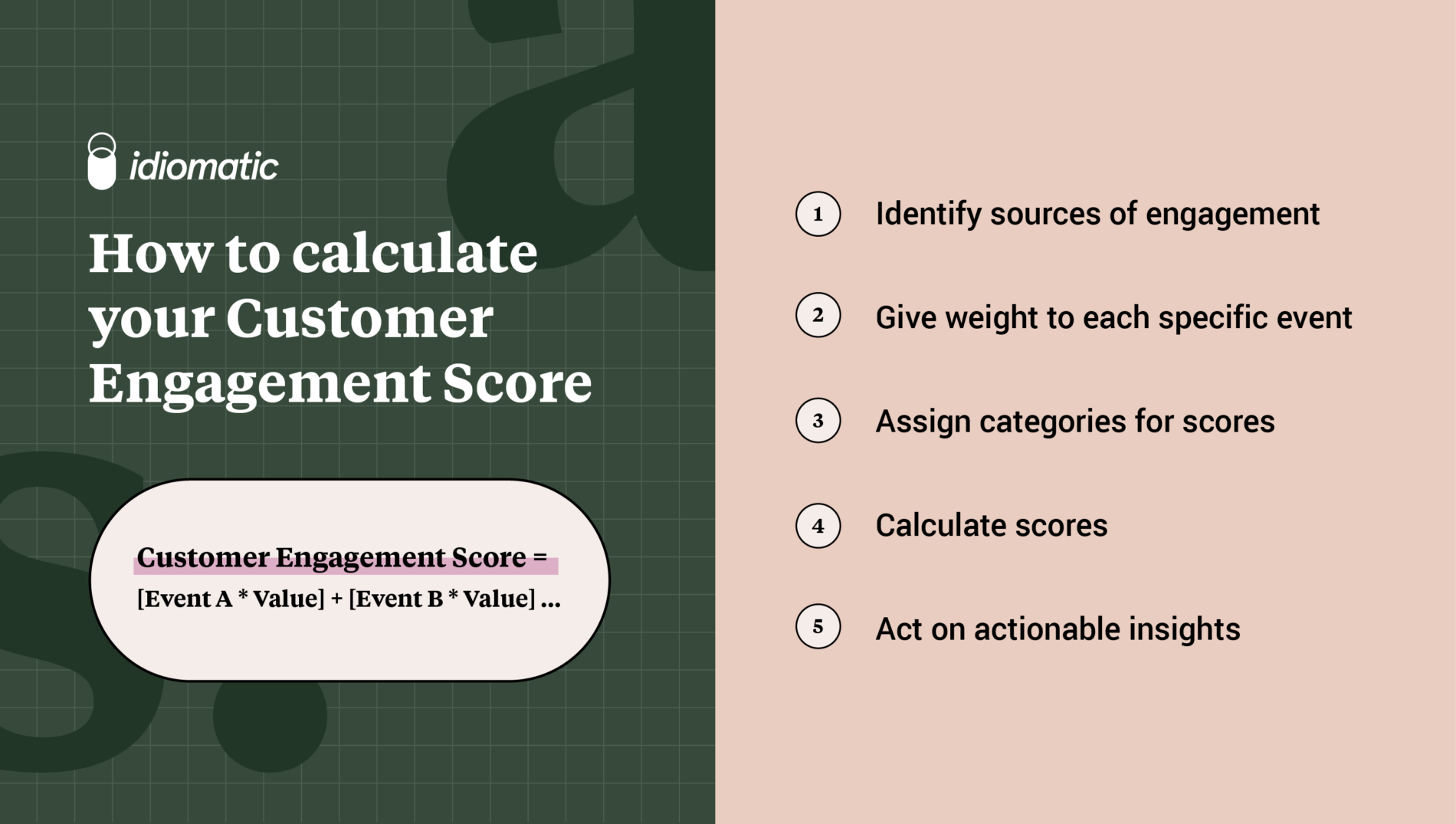How would it change your business if you could predict customer retention and churn? Imagine having the data-backed insights to know exactly how to increase customer engagement and satisfaction. When you know your customer engagement scores and other user engagement metrics, you’re one step closer to discovering what drives your customer’s loyalty or disloyalty.
Your Customer Engagement Score (CES) plays a critical role in understanding the customer journey. Measuring customer engagement will help you know where they may struggle to utilize your products and services or interact with your brand, and where you can provide more support to keep customers engaged at the right times. You’ll be able to identify customers who need your help and get them the help they need, either through 1:1 support or through business changes to impact many similar customers at once.
In this article, we’ll look at how to calculate your Customer Engagement Score, how this information is helpful for your business, and how using AI for analysis can yield more powerful results.
Contents
What is the Customer Engagement Score (CES)?
Customer Engagement Score measures how engaged your customers and free trial prospects are with your brand. Each customer is given a unique score based on:
- Conversations with your brand (through various touch points like social media, your help desk, chat bot, etc.)
- Measurable usage of your product or service (such as login frequency, time using your app, or other metrics related to how they use or don’t use your offerings)
This information provides granular data on each customer. The higher the Customer Engagement Score, the healthier the customer or prospect is. You can further categorize your customers by demographics or specific traits (such as purchase history or length as a customer) for an overall view of a specific customer segment.
How to calculate your Customer Engagement Score

Measure your Customer Engagement Score by using the following formula:
Customer Engagement Score =
[Event A * Value] + [Event B * Value] …
In this formula, you’ll identify key events that indicate a positive or negative engagement with your brand. Each event is assigned a score and you’ll track engagement events for each customer to calculate the total score.
To get the customer engagement score values for the above formula, follow these five steps:
Step 1: Identify sources of engagement
What metrics related to how a customer interacts with your brand, products, or services are you currently tracking? If it’s a helpful engagement metric, ensure you have tracking set up to measure it. For example, it would be beneficial to track how many times a current customer browses your knowledge base, but if you don’t have analytics in place to track this and link it to an individual customer, this metric won’t be helpful in your engagement scores.
You don’t need to include every trackable metric in this calculation; just the ones you feel accurately indicate engagement. The sources of engagement you use will be unique to your company and business model but may include the following:
- Contacting customer support or the help desk
- Logging into their account
- Frequency of login
- Frequency of repeat purchases
- Social media comments, likes, and shares
- Mobile app usage
- Participation in online forums or groups (related to your business)
- Website usage (bounce rate, pages viewed, time spent on site)
Step 2: Give weight to each specific event
Assign each of your identified engagement events with a weighted score. The higher the score you give that event, the more it shows active engagement. For example, logging into their account doesn’t necessarily show active engagement, but making purchases or contacting customer success teams may justify a higher score.
Step 3: Assign categories for scores
When you calculate customer engagement scores, you get a number. For better analysis, it helps to assign categories to each score. Here are some examples of how you can contextualize your customer engagement scores:
- Negative score = Very likely to churn (low hope of turning into a customer)
- Scores less than 20 = Likely to churn
- Scores between 21-40 = Somewhat disengaged
- Scores between 41-70 = Engaged
- Scores between 71-99 = Highly engaged (loyal)
- Scores 100+ = Most engaged customers (power users)
After you’ve assigned score categories, you’re ready to begin calculating scores.
Step 4: Calculate scores
Now, gather all your data and calculate each user customer engagement score. Use an integration or automation to calculate your scores automatically when engagement events occur. Just knowing your customers’ engagement score isn’t enough, though. In order to make meaningful business decisions, you need to know the “why” behind their score.
Link your customer engagement scores and customer feedback data to a customer experience management platform like Idiomatic. Idiomatic’s machine learning models understand human speech and the relationship between words, which helps you further analyze all your customer feedback data to understand the “why” behind the scores (at a deeper level than just a ranked contextualization). Idiomatic also allows you to derive tangible, actionable insights from your customer feedback data, to further identify what makes high-scoring customers engaged and how you can improve the experience for the customers with low customer engagement scores.
Step 5: Act on actionable insights
Once you understand the voice of your customer in the depth as described above, you can make changes to encourage more engaged users and increase customer loyalty.
Idiomatic looks at your Customer Engagement Scores, using other Voice of Customer and customer feedback data sources (such as surveys and customer support request records), and helps you identify tangible, actionable insights you can act on to increase customer engagement. Idiomatic can look at verbatim comments and feedback at scale, tag and analyze it, and produce a data-driven picture of the voice of the customer and customer sentiment—all by using advanced machine learning.
Without this advanced level of AI analysis, you may see that a customer has a high Customer Engagement Score and leave them alone, thinking they’re a low churn risk. However, if that customer has contacted support several times and filled in a NPS survey indicating dissatisfaction with your product features, Idiomatic can identify these customers. Idiomatic’s advanced machine learning can fill in these gaps and see the customers from all perspectives for a more accurate representation of engagement and customer satisfaction.

How is a Customer Engagement Score used in business?
In most cases, disengaged customers are less likely to make repeat purchases, renew subscriptions, or remain loyal than more engaged customers. This isn’t always the case, however, so understanding the reasoning behind your customer engagement scores is important.
For example, you may have a customer who logs into their account daily. Based on your engagement event value for “Account Login,” you’d assign 1 point for each login. This will rack up a big score quickly; however, if they don’t do anything inside the app other than just logging in daily, logic says this isn’t necessarily a customer actively engaging with your brand.
To get the full picture you need to know what a customer does (engagement events) and what they think or say (like survey data, social media comments, and help desk conversations). Using machine learning analysis, you can consider both Customer Engagement Scores and Voice of Customer data to help you better understand the reason behind the score.
Example of customer trends you can uncover
The insights you get from calculating customer engagement scores can be summarized by a specific customer demographic, customer journey stage, or any other customer metric. With this categorized data, you can uncover trends like:
- Free trial users with high engagement are more likely to subscribe at the end of their term.
- You see a spike in engagement after you send out email marketing campaigns.
- Users become less engaged after subscribing to your premium package.
- Freemium users tend to be most engaged in the first seven days of activating their accounts. Then, engagement drops significantly.
Why Customer Engagement Score is an important KPI
Customer engagement score can support other metrics and analytics you may be tracking. On its own, it gives you a general understanding of customer behavior for your existing customers. Using just customer engagement data, you can track which customer engagement events happen most frequently and when.
When you combine this data with other KPIs, you can uncover many business opportunities, including discovering how to convert more free trial prospects to paid accounts, identifying customers likely to be upsold to a higher package, and identifying customers who are struggling to engage with your offerings and brand, and likely to churn without your intervention.
Other helpful KPIs to measure engaged customers
Get the most detailed understanding of your customer by using multiple KPIs to measure active users. Measure customer interactions, engagement, and satisfaction, with Customer Engagement Scores and these other common business metrics:
Net Promoter Score (NPS)
Your Net Promoter Score is a market research metric populated by asking customers to rate the likelihood they would recommend a company, product, or service to a friend, family member, or colleague on a scale from 1 to 10. This score correlates to customer satisfaction, as mostly engaged, loyal customers are more likely to recommend you to others.
Learn more about Net Promoter Scores.
Customer Effort Score
Customer Effort Score tells you how much effort a customer feels they must put in to meet their needs. An increased effort may correlate to dissatisfaction and affect customer engagement scores as they may “hunt” around to find what they need. This “hunting” may translate to higher engagement and effort scores, but they’re actually not engaged positively; they’re struggling to find what they need.
Customer Satisfaction Score (CSAT)
A Customer Satisfaction Score is a metric used to determine how happy customers are with a business’s brand, offerings, or interactions. It’s usually just one question that asks customers to rank their satisfaction with a specific aspect of your business or an interaction they’ve had with your team. With this score, you can look for new ways to delight your customers, increasing their satisfaction and brand loyalty.
Learn more about Customer Satisfaction scores
Website analytics
Track how customers engage with you through your website or online assets. If you can correlate each website action to a specific user, you’ll get a very granular view of each individual. If you can’t link website traffic to specific users, it’s still helpful to know, at a higher level, how people are interacting with your online assets.
How to improve your Customer Engagement Scores
The ultimate goal of knowing a customer engagement score, and other customer engagement metrics, is to understand your customers better and inform the right business decisions to increase customer satisfaction and loyalty as well as support your business goals. You can understand which business areas need improvement when you track customer engagement.
For example, here are some examples of ways to improve your customer engagement score:
- Personalize the onboarding experience with in-app marketing.
- Add gamification to the customer experience.
- Provide customers with checklists or walk-throughs.
- Reach out to customers directly to solve their problems.
- Provide upgrades or complementary add-ons to engaged customers to increase their loyalty and engagement.
- Remove friction to reach customer goals (i.e., make it easier for customers to speak to a customer services rep).
- Change included features in the premium or freemium versions of your software.
- Add additional customer touchpoints where customers are less engaged or need extra support.
Learn more about increasing customer engagement.
How to understand customer engagement with machine learning
Machine learning helps you identify the reason behind a Customer Engagement Score. Idiomatic analyzes the meaning and intent behind every piece of customer feedback using machine learning, to show you the whole story of why customers are, or are not, engaged with your brand. As a result of this analysis, you can listen to the voice of your customer, and identify what you should do to keep customers happy and win new ones.
Listening to the voice of the customer in this way minimizes misinterpretation of customer engagement. For example, if your data gives a customer a high engagement score but notes they’ve contacted your help desk many times in the past 30 days, that may not indicate a loyal, delighted customer. Combining Customer Engagement Score with Idiomatic’s customer feedback analysis allows you to fill in the gaps to get a better, more informed view of your customers.
See how Idiomatic can help you fill these gaps in understanding your customer engagement score. Request a demo today to learn more.




